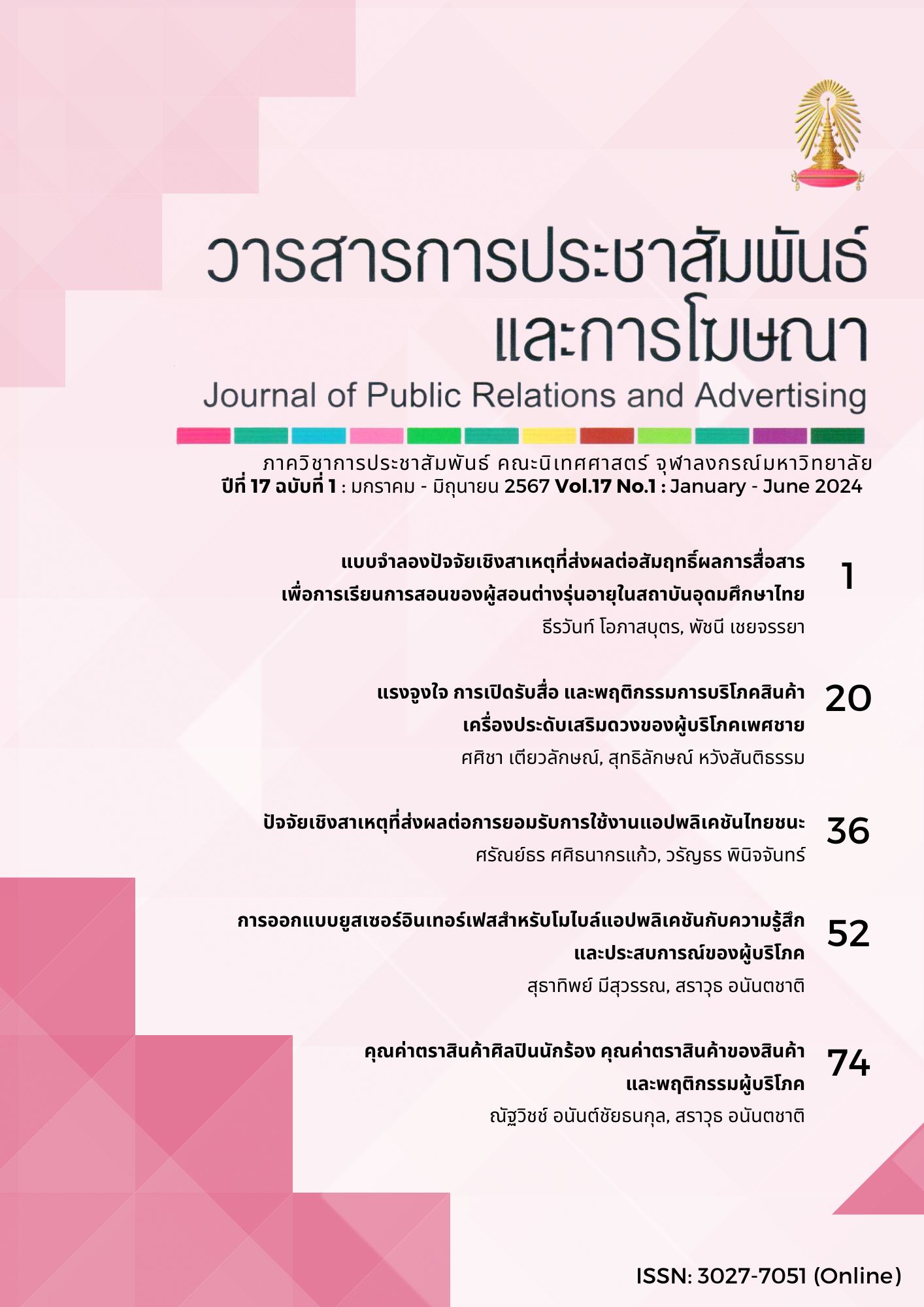A Causal Model of Factors Affecting Instructional Communication Effectiveness of Instructors of Different Generations in Thai Higher Education Institutions
Main Article Content
Abstract
The objectives of this research were to 1) develop causal models of factors affecting instructional communication effectiveness of instructors of different generations in Thai higher education institutions, and 2) examine the congruence of the constructed model with the empirical data. This research is a quantitative method research, by collecting data from a sample of 195 students aged over 20 years old, who had learning experiences with instructors from the three different generations for at least one academic year. The instructors were required to have at least 10 years of teaching experience. The quantitative research findings reveal that all constructed causal models affecting instructional communication effectiveness of instructors of different generations in Thai higher education institutions are congruent with the empirical data at a statistical significance level of 0.05, 0.01, and 0.001. Considering the congruence indices, the causal model of Gen B Gen X Gen Y and instructors of all generations. All models have 8 out of 11 indices pass the determined criteria, with the following findings: 1) The model of Gen B instructors: Perceived communication competence has a direct positive effect on communication satisfaction, communication satisfaction has a direct positive effect on response to communication and perceived communication problems have a direct positive effect on communication satisfaction. 2) The model of Gen X instructors: Perceived communication competence has a direct positive effect on communication satisfaction and perceived communication competence has a direct positive effect on response to communication. 3) The model of Gen Y instructors: Perceived communication competence has a direct positive effect on communication satisfaction and communication satisfaction has a direct positive effect on response to communication and 4) The model of instructors of all generations: Perceived communication competence has a direct positive effect on communication satisfaction and communication satisfaction has a direct positive effect on response to communication. Overall, the variable of perceived communication competence has the highest total effect on communication satisfaction in all models.
Article Details
References
เกวลี ขันธ์เงิน. (2553). การพัฒนาความสามารถในการสื่อสารของพนักงานใหม่ในองค์กรไทยมหาวิทยาลัย. (วิทยานิพนธ์นิเทศศาสตรมหาบัณฑิต). จุฬาลงกรณ์มหาวิทยาลัย, คณะนิเทศศาสตร์.
ชิตาภา สุขพลำ. (2548). การสื่อสารระหว่างบุคคล. กรุงเทพฯ: โอเดียนสโตร์.
ชัชฏาพันธ์ อยู่เพชร. (2555). ปัจจัยที่ส่งผลต่อผลสัมฤทธ์ิทางการเรียนของนักศึกษาช้ันปีที่ 2 ภาคปกติคณะครุศาสตร์ มหาวิทยาลัยราชภัฏพิบูลสงคราม. การศึกษาค้นคว้าด้วยตนเอง หลักสูตรการศึกษามหาบัณฑิตสาขาวิจัยและประเมินผลการศึกษา มหาวิทยาลัยนเรศวร.
เติมศักดิ์ คทวณิช. (2546). จิตวิทยาท่ัวไป. กรุงเทพฯ: ซีเอ็ดยูเคชั่น.
ธรรมรัตน์ อยู่พรต. (2556). ค่านิยมในการทำงานที่ส่งผลต่อพฤติกรรมการเป็นสมาชิกที่ดีขององค์กรของเจนเนอเรชั่นต่าง ๆ. วารสารบริหารธุรกิจ. 36, 138 (เมษายน-มิถุนายน)
นงลักษณ์ ศรีอัษฎาพร เจริญงาม. (2541). ความสามารถในการสื่อสาร: แนวคิดเชิงวัฒนธรรมในองค์กรไทย. โลกของสื่อ ปีที่ 1 (ลำดับที่ 2 (มิถุนายน)).
________________________. (2541). ความสามารถในการสื่อสารแนวคิดเชิงนิเวศในองค์กร. วารสารนิเทศศาสตร์ . 18(4), 1-18.
นรดี กิจบูรณะ. (2537). ผลของการเพิ่มปฏิสัมพันธ์ระหว่างครูและนักเรียนต่อพฤติกรรมตั้งใจเรียน และ ผลสัมฤทธิ์ทางการเรียนวิชาภาษาไทยของนักเรียนชั้นประถมศึกษาปีที่ 3 ที่มีความบกพร่องทางการได้ยิน. วิทยานิพนธ์ปริญญา
ครุศาสตรมหาบัณฑิต จุฬาลงกรณ์มหาวิทยาลัย.
บุรณี ทรัพย์ถนอม และปัทมา มูลหงส์. (2552). ปัจจัยที่ส่งผลต่อผลสัมฤทธิ์ทางการเรียนสาขาวิชาการบัญชีของนักศึกษาคณะบริหารธุรกิจ. มหาวิทยาลัยเทคโนโลยีราชมงคลพระนคร.
ปภัสสรา ชัยวงศ์. (2557). กรอบแนวคิดเชิงทฤษฎีความสามารถในการสื่อสารระหว่างบุคลากรต่างรุ่นในองค์กรไทย. (วิทยานิพนธ์ปริญญานิเทศศาสตรดุษฎีบัณฑิต). จุฬาลงกรณ์มหาวิทยาลัย, คณะนิเทศศาสตร์.
พิบูล ทีปะปาล. (2545). การโฆษณาและการส่งเสริมการขาย. กรุงเทพฯ: มิตรสัมพันธ์กราฟฟิค.
ภาวรรณ ธนาเลิศสมบูรณ์. (2563). อย่าให้ ‘เจนฯ’ เป็นเส้นคั่นระหว่างเรา : จุดอ่อนของการมองโลกแบบเจเนอเรชัน. วันที่เข้าถึงข้อมูล 25 ตุลาคม, 2563 แหล่งที่มา https://www.the101.world/family-generation/
มหาวิทยาลัยสุโขทัยธรรมาธิราช. (2556). การพัฒนาเคร่ืองมือวัดด้านเจตพิสัยและทักษะพิสัย. นนทบุรี: มหาวิทยาลัย
สุโขทัยธรรมาธิราช.
เมตตา วิวัฒนานุกูล. (2559). การสื่อสารระหว่างวัฒนธรรม. กรุงเทพฯ: สำนักพิมพ์แห่งจุฬาลงกรณ์มหาวิทยาลัย.
วิไล พึ่งผล ประสพชัย พสุนนท์ และธีระวัฒน์ จันทึก. (2561). การวิเคราะห์คุณลักษณะของเจนเนอร์เรชั่นวายยุคประเทศไทย 4.0: กรณีศึกษานักศึกษาชั้นปีที่ 4 มหาวิทยาลัยเอกชนแห่งหนึ่ง. วารสารการวิจัยเพื่อพัฒนาชุมชน (มนุษยศาสตร์และสังคมศาสตร์), 11(2)
วิไลวรรณ จันทร. (2541). ปัจจัยที่ทำให้นักศึกษาวิศวกรรมศาสตร์มีผลการเรียนต่ำ. (รายงานการวิจัย). เชียงใหม่: มหาวิทยาลัยเชียงใหม่.
สมยศ นาวีการ. (2549). การบริหารและพฤติกรรมองค์การ. (พิมพ์ครั้งที่ 4). กรุงเทพฯ: บรรณกิจ.
สุขุม เฉลยทรัพย์. (2561). ‘มหาวิทยาลัยไทย’ ทำอย่างไร? จึงจะอยู่‘รอด’. วันที่เข้าถึงข้อมูล 28 กุมภาพันธ์, 2563 แหล่งที่มา https://www.matichon.co.th/columnists/news_810261
สุชาดา สุขเสถียรพาณิชย์. (2545). ความสามารถทางการสื่อสารระหว่างบุคคลในบริษัทนานาชาติญี่ปุ่น. (วิทยานิพนธ์ปริญญานิเทศศาสตรมหาบัณฑิต). จุฬาลงกรณ์มหาวิทยาลัย, คณะนิเทศศาสตร์.
สุมาลี รามนัฎ. (2552). การศึกษาปัญหาและอุปสรรคที่มีผลกระทบให้นักศึกษามีผลสัมฤทธิ์ทางการเรียนต่ำของนักศึกษามหาวิทยาลัยเอเชียอาคเนย์ ปีการศึกษา 2552. (รายงานการวิจัย). มหาวิทยาลัยเอเชียอาคเนย์.
สุรชัย กังวล. (2557). การวิเคราะห์เส้นทางความสัมพันธ์เชิงสาเหตุที่่มีอิทธิพลต่อผลสัมฤทธ์ิทางการเรียน ของนักศึกษาสาขาเศรษฐศาสตร์สหกรณ์. (รายงานการวิจัย). มหาวิทยาลัยแม่โจ้.
หทัยพร ทิมสว่าง. (2551). การพัฒนาความสามารถในการสื่อสารสำหรับบุคลากรผู้มีศักยภาพสูงในองค์กรเอกชน. (วิทยานิพนธ์ปริญญานิเทศศาสตรมหาบัณฑิต). จุฬาลงกรณ์มหาวิทยาลัย, คณะนิเทศศาสตร์.
อรอนงค์ สวัสดิ์บุรี. (2555). พฤติกรรมการสื่อสารในองค์การ. กรุงเทพฯ: จุฬาลงกรณ์มหาวิทยาลัย.
Hofstede, G. (1980). Culture’s Consequences: International Differences in Work-Related Values. Beverly Hills. CA: Sage.
Lyons, S., Duxbury, L. and Higgins, C. (2007). An empirical assessment of generational differences in basic human value, Psychological Reports, 101, 339–352.
Maslow, A. H. (1970). Motivation and Personality. 2nd ed. New York: Harper and Row.
McComb, M. E., & Becker, L. B. (1979). Using Mass Communication Theory: Perception in Mass Communication. Englewood Cliffs. New Jersey: Prentice-Hall.
McCroskey, J., Richmond, V., & McCroskey, L. (2006). An Introduction to Communication in the classroom. Boston: Pearson.
McQuail, D., J.G. Blumler & J.R. Brown. (1972). The Television Audience: A Revised Perspective. Sociology of Mass Communication. Middlesex, UK: Penguin.
Mottet, T. P., Richmond, V. P., & McCroskey, J. C. (2006). Handbook of Instructional Communication: Rhetorical and Relational Perspectives. New York: Allyn & Bacon.


